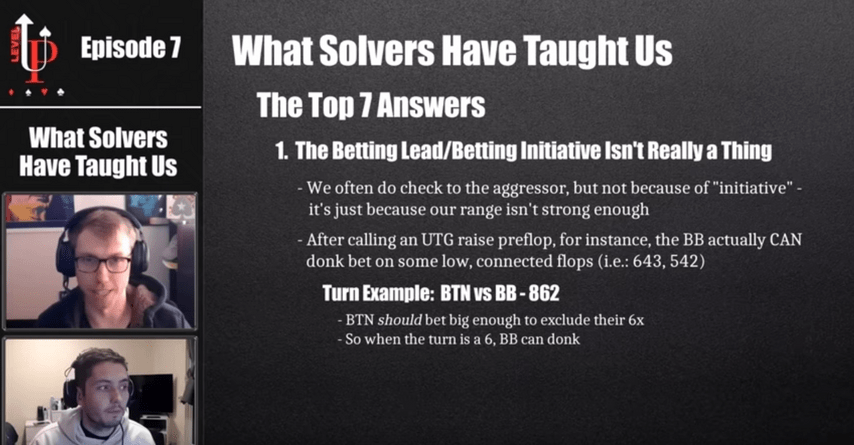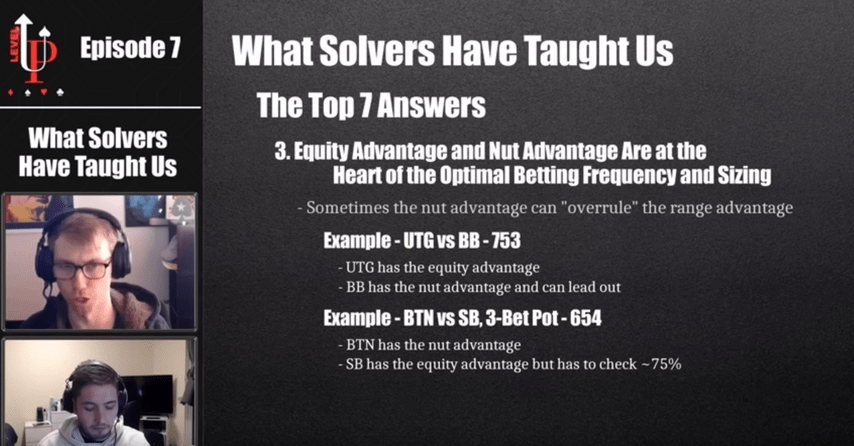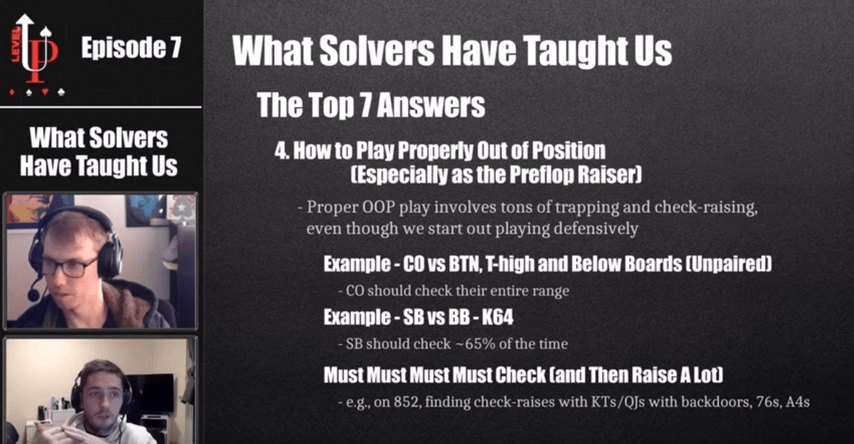Since the beginning of the year, the Level Up podcast has been airing on Doug Polk School's YT channel, specializing in poker lessons for skilled players. The most spectacular of them focuses on the main strategic techniques that players have discovered since the advent of solvers. Some of them the regulars understood intuitively before, while others became a real revolution.
For this video, Mike Brady asked mid and high-stakes players what they consider the most important concepts and mechanics brought by solvers. The seven most popular answers formed the basis of his analysis.
1. Initiative in the hand is a myth
Once upon a time, players always checked to the aggressor, because he had the so-called "initiative". There was a lot of talk about keeping the lead in the hand, and many explained the decision to keep betting. It turned out that all this is complete nonsense. Of course, we still often check to the aggressor, but the initiative has nothing to do with it at all, it's all about the equity advantage.
For example, the button opened, we defended the BB, and the flop was K82. We check, not because the button has the initiative, but because we have a much weaker range – and no action other than a check can be justified here. But there are many situations when you should donk lead. A few years ago, when someone led the flop, he was immediately flagged as a fish. And solvers have shown that the lead is often the right game.
The UTG player raised, the BB defended, and the flop was 643 or 542. Leading would be a perfectly reasonable action because on these flops the BB simply destroys the UTG raiser's range. It's the same on other streets: for example, the BB paid a continuation bet from the button on a flop of 862. The button here often has to bet big and far from the whole range, while he usually does not have sixes in such a bet. And if the turn hits another six, the BB can lead because he has a range advantage and the nuts.

2. Small bets can be even smaller. Large – even bigger
The gold standard of 33% was discovered by some players before solvers, but it has become popular in recent years. It also turned out that sometimes you need to bet 25% of the pot and even less. For example, in a 4-bet pot on an AA2 or AQ3 flop, it makes sense to bet 10% of the pot.
The effectiveness of overbets was also revealed to us by solvers. Now it's not surprising to bet 150% or 200% of the pot on the turn and river. But remember how we watched the match between Isildur and Tom Dwan, and when one of them shoved 200% of the pot – everyone was in shock, they say, madness! And then the solvers showed that, in fact, sometimes this is the standard. And many strong regs have adopted it since then. Look at Michael Addamo in live tournaments, with deep stacks he can bet 10 pots.
3. Equity and Nut Advantages Determine Betting Frequency and Sizings
Equity advantage (also called range advantage) is when your range has more equity than your opponent's. And the advantage in the nuts shows who has more very strong hands (two pair, sets, straights, flushes, overpairs on some boards).
This point generally follows from the previous two. Range and nut advantages govern everything we do in a hand. There is a range advantage – we can bet, there is an advantage in the nuts – we can lead, overbet. In this case, the equity advantage usually remains with the raiser: for example, if you protect the BB against the button, then you will never have it. But the advantage in the nuts can be much more important. For example, UTG raises, the BB defends, and on a flop, the BB has it and can lead (although the raiser still has a range advantage).
It works the other way too: if the button opens, you 3-bet from the SB, get called and the flop comes , the button has a lot more nuts, and you have to check about 75% of the time, even though you have more overpairs in your range. Being less likely to have the nuts forces you to play passively.

4. Raiser out of position needs to play defensively
The OOP raiser's strategy includes a lot of traps, and check-raises – but not so many continuation bets! 7-8 years ago, even strong players would raise preflop, get called by the button, and in most cases automatically c-bet. The solvers explained that out of position, a raiser should check more often. And when the opponent bets, you can already connect check-raises – both for value and as a bluff. That is, the game is mega-aggressive, but very often starts with a check.
This aspect of the game has changed beyond recognition since the advent of solvers. Why should we play so passively out of position? The answer is in the question – because we (Eureka!) are out of position! If we have a wide c-bet range, Villain can float us very successfully. Then we check the turn, Villain bets, and we're in a terrible position.
Let's say you raise from the cutoff, and the button calls. The solver checks with the entire range of any unpaired flop Ten-high and below – no one could have imagined this eight years ago. Or you raise from the SB, the BB calls. The solver checks the flop about 65% of the time, while regulars used to bet here almost always.
But at the same time, you definitely need a powerful and super-aggressive check-raising strategy. And not just with overpairs, sets, and strong top pairs, it's easy. But you also have to find check-raises with bluffs: for example, on an flop it could be KTs/QJs with a flush backdoor, 67s, A4s. If you don't learn how to attack with these hands, your opponents will run you over.
Further, if you have a wide check range, then the player in position will have a wide betting range, including with air. This means that your weak hands must counterattack to knock out stronger empty hands. It's also important to keep your opponents from realizing equity because if you never check-raise the flop, they'll always see the turn. Check-raising is also a great weapon against players who like to bet the flop in position in the hope of check-checking the turn and thus seeing the river cheaply. Solvers have taught us how to put pressure on fans of this technique.

5. Unintuitive blocker effects
In the past, players often bluffed the river with a missed flush draw. Now we know that the solver does not approve of such bluffs, because the hand blocks the flush draw in the villain's range, which means that we will get called more often. Conversely, the player who got bet into on the river just wants to have blockers on a missed flush draw, because Villain shouldn't be bluffing with a flush draw (which means he'll have more hands to bluff in his range). This is not very intuitive, players often do not understand this. They say, "I have AJ with A spades, so it was bad to call with top pair of jacks because I have an ace of spades that blocks bluffs." In fact, the opponent should not be bluffing with spades, so is a good blocker for calling. Before the solvers, no one really thought about it that way.
And yet no one understood that unblocking is no less important than blocking. Let's say you 3-bet from the SB against the button, the flop is . Bet a logical continuation bet with the whole range, and you get called. On the turn, you need to barrel bluff more often with cards of the suit that is not on the flop (that is, with hearts) – after all, your opponent will often float the flop with flush backdoors. You don't block these backdoors if you don't have spades, diamonds, and clubs – and therefore a solver with hearts in hand will bluff more often.
6. There are many reasons to block bet
You bet small to prevent your opponent from betting a lot – this is not a very accurate definition of a blocking bet (in the magical world of the solver, it all justifies a little differently), but it is the simplest. But it is important to understand that if you bet on the river, you should have not only small sizing in your arsenal but also large ones (and bluffs should also be included in the large one so that the range consists of not only value).
Solver explained that block betting is not just about preventing your opponent from betting more. Most importantly, you can bet very wide for value. Let's say the board is checked to the river and you can bet with fourth pair, sometimes even A-high. Sizing can often be chosen depending on the position: for example, a large bet size with top pair is great against the button and a small one against MP.
Bluff bet sizes vary depending on your opponent's range, and it can also be very small (like block betting a fourth pair) – and when it works (like betting 12% of the pot and taking the pot), you're printing money. But sometimes strong hands should be included in small sizing, otherwise the opponent will print money when he starts raising you every time.

7. GTO is an unthinkable aggressive strategy
Solver plays like a maniac. Even the most aggressive regulars of the pre-solver era, who threw chips all over the place, were not as aggressive. The solver endlessly finds all these crazy spots for check-raising or huge overbets. This is the gangster we all learn to play from. Remember Michael Addamo again: he took the concept of aggression to a new level, and he can play it because he knows it's right.
Even regulars learning GTO play much more passively than a solver. Nobody calls that much and nobody bluffs that much. The button opened, the BB defended, andthe flop was . Regulars, of course, check-raise this flop from the BB, but not as often as the solver (25-30% of the time!). And how lightly he opens it is a completely different story, people are simply not capable of this. In addition, he uses different sizings and even does it in a balanced way, it is impossible to resist this style. So we will continue to try to get closer to that game – but it will continue to surprise us again and again.











